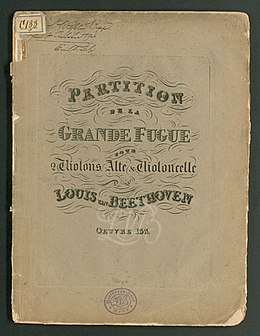| Grosse Fuge | |
|---|---|
| Late string quartet by Ludwig van Beethoven | |
 Title page of the first edition of the Grosse Fuge, published in Vienna by Matthias Artaria in 1827 (in French, with the title Grande Fugue and Beethoven's French name "Louis") | |
| English | Great Fugue |
| Key | B♭ major |
| Opus | 133 |
| Form | Fugue |
| Composed | 1825 |
| Dedication | Archduke Rudolf of Austria |
| Duration | About 16 minutes |
| Scoring | String quartet |
| Premiere | |
| Date | 1826 |
| Performers | Schuppanzigh Quartet |
| Live performance | |
Merel Quartet at Tonhalle, Zürich, 3 July 2013: Mary Ellen Woodside and Julia Schröder, violin; Ylvali Zilliacus, viola; Rafael Rosenfeld, cello | |
The Grosse Fuge (German: Große Fuge, also known in English as the Great Fugue or Grand Fugue), Op. 133, is a single-movement composition for string quartet by Ludwig van Beethoven. An immense double fugue, it was universally condemned by contemporary music critics. A reviewer writing for the Allgemeine musikalische Zeitung in 1826 described the fugue as "incomprehensible, like Chinese" and "a confusion of Babel".[1] However, critical opinion of the work has risen steadily since the early 20th century and it is now considered among Beethoven's greatest achievements. Igor Stravinsky described it as "an absolutely contemporary piece of music that will be contemporary forever".[2]
The Grosse Fuge was originally composed as the final movement of Beethoven's Quartet No. 13 in B♭ major, Op. 130, written in 1825; but Beethoven's publisher was concerned about the dismal commercial prospects of the piece and wanted the composer to replace the fugue with a new finale. Beethoven complied, and the Grosse Fuge was published as a separate work in 1827 as Op. 133. The work was composed when Beethoven was nearly totally deaf, and is considered to be part of his set of late quartets. The Grosse Fuge was first performed in 1826, as the finale of the B♭ quartet, by the Schuppanzigh Quartet.
Music analysts and critics have described the Grosse Fuge as "inaccessible",[3] "eccentric",[4] "filled with paradoxes",[5] and "Armageddon".[6] Critic and musicologist Joseph Kerman calls it "the most problematic single work in Beethoven's output and ... doubtless in the entire literature of music",[7] and violinist David Matthews describes it as "fiendishly difficult to play".[8]
- ^ Solomon (2003), p. 35.
- ^ Stravinsky & Craft (1963), p. 24.
- ^ B. H. Haggin, quoted in Chamber Music Northwest Archived 21 May 2014 at the Wayback Machine
- ^ Kinderman (1995), p. 307.
- ^ Levy (2007), p. 130.
- ^ Arnold Steinhardt, in Miller (2006), p. 40
- ^ Kerman (1979), p. 279.
- ^ Matthews (2006), p. 28. For a discussion of the technical and musical difficulties of the fugue, see § Performance challenges.